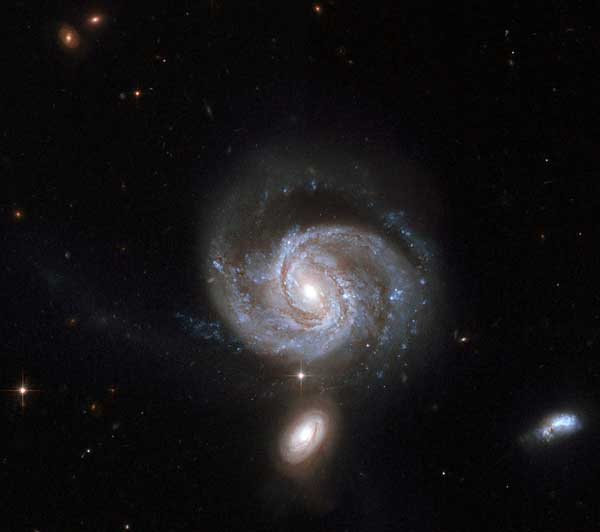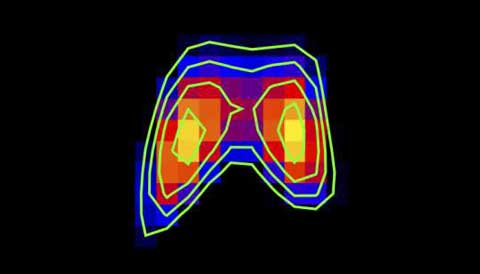Astronomers have found what could be the closest known pair of supermassive black holes detected via direct imaging, orbiting each other only a light-year apart.

NASA / ESA / the Hubble Heritage Team (STScI/AURA) / ESA / Hubble Collaboration / A. Evans (Univ. of Virginia, Charlottesville / NRAO / Stony Brook Univ.)
If you think your life is busy, imagine the life of Mrk 533. This active galaxy is the largest and brightest member of its group, and its tidal tails are testament to its busy social life — interactions with its companions are literally tearing the galaxy in all directions.
One of those interactions may have come a little too close. New observations reported in the September 18th Nature Astronomy reveal a double radio source at the center of Mrk 533, possibly the emission from a close pair of supermassive black holes separated by only a light-year in their orbits. The closest pair of directly imaged supermassive black holes known until now, discovered in the galaxy 0402+379, orbits 24 light-years apart.
Gravitational swipes from smaller galaxies are probably responsible for the gas that’s spiraling down to feed the putative pair of black hole beasts at the heart of Mrk 533. Even though we view the galaxy face on, observations show that we see the central black hole(s) equator-on, and a thick veil of dust and gas hides much of the emission. Preeti Kharb (National Centre for Radio Astrophysics, India) and colleagues used the Very Long Baseline Array (VLBA) to peer through this veil and into Mrk 533’s core. Probing various radio frequencies, the team found that the single source of radio emission resolved into two sources at 15 GHz.
One possibility is that the radio waves emanate from a pair of supermassive black holes with a combined mass of 40 million Suns, orbiting each other about a light-year apart. If so, then this is the closest pair of central black holes detected via direct imaging — a boon for observers and theorists alike.
Large galaxies are thought to grow by merging with other galaxies, and most large galaxies host a supermassive black hole. So it’s only natural that some large galaxies in the late stages of a merger would host not one but two black holes, bound together in an inward-spiraling orbit. But such pairs — especially close ones — have proven surprisingly difficult to find.
Without many examples to guide them, theorists have struggled to understand how two supermassive black holes swinging by each other at tremendous speed could lose enough angular momentum to merge. It could be that the black holes’ interactions with surrounding gas and dust helps them come together, but that remains to be seen in observations.

Tata Institute of Fundamental Research-National Center for Radio Astrophysics / Rochester Institute of Technology
Including this one: This double radio core is still labeled as a candidate supermassive black hole binary. The VLBA observations only detect the double source in Mrk 533 at a single frequency, and without detections at other frequencies, it’s difficult to nail down the sources’ spectra and rule out alternatives for the radio emission. It’s possible, for example, that one of the radio sources is a black hole, but the other is simply the black hole’s jet rather than another black hole.
That said, there are some factors that favor the double black hole scenario. For example, Mrk 533's stubby radio-emitting jets, extending some 2,000 light-years, have an unusual Z shape. “This morphology is thought to result from the combined effects of the galaxy merger followed by the formation of the massive binary,” says study coauthor David Merritt (Rochester Institute of Technology).
“If the system is confirmed to be a SMBHB system with a separation of just 0.35 parsec [1 light-year], then this will be very interesting,” says Gregory Taylor (University of New Mexico). “This will improve our constraints on the occurrence rate of binary black holes in mergers, and tell us more about how binary black holes merge.”
 6
6









Comments
anadish
September 20, 2017 at 10:57 pm
It is quite probable, but it is impossible for any interferometer based GW receiver to sense such a GW wave from a future merger of these reported suspected black holes. It is impossible. even, if the interferometer is thousands of miles long. Primarily, because, gravity still travels at infinite speed as proposed by Newton; Einstein, indeed, could not change the speed. Let me add, 6 years earlier, minuscule gravitational waves of a wide frequency range (nearly zero to around 3 KHz) were first produced and detected in my lab late in 2010 and were reported in a US patent application which now is a US patent 8521029. You can find the patent detail on the USPTO site as well as on google patents . You can check out gravitational waves and my work on Wikipedia. Let me also add, even if I am letting out a little secret, it is impossible to register any black hole mergers otherwise too, primarily because of the sheer volume of mergers -- I cannot talk more on this subject -- besides due to too much of GW noise present around us (read in my patent about how this noise is generated). So, let me tell you, LIGO actually never detected any black hole mergers in the past too. The least I can say is that the reported mergers were a result of the intense imagination of the LIGO folks, to say the least. Unless LIGO is not confident of their so-called GW wave findings from BH mergers, why should they be tweeting this research with excitement? Then let us not forget it is a finding by a low-credibility Indian team and India has staked USD300 million for a disused LIGO setup to be shipped to India with a new name INDIGO.
You must be logged in to post a comment.
September 28, 2017 at 9:46 am
I will answer the would-be rhetorical question you asked. Because they are human beings and have passion.
Your ad hominem argument is logically fallacious. Best to use evidence and relevant factors when assessing scientific claims. Tsk! Tsk!
You must be logged in to post a comment.
Marshall Eubanks
September 21, 2017 at 10:21 am
Interesting article, but this is not the closest known SMB binary.
The SMB binary OJ287 has an estimated semi-major axis of 0.174 light years.
https://arxiv.org/abs/1305.1122
You must be logged in to post a comment.
Monica YoungPost Author
September 21, 2017 at 11:26 am
Thanks for the correction, Marshall. This article should have said that the pair are the closest detected *via direct imaging* and I've made those corrections to the text.
You must be logged in to post a comment.
Anthony Barreiro
September 22, 2017 at 5:41 pm
Mrk 533 is also catalogued as NGC 7674. It's a 13th magnitude galaxy in Pegasus, appearing about 1 x 1 arcminutes in diameter, 420 million light years distant. You could see it tonight through a 10 inch telescope in a reasonably dark sky.
You must be logged in to post a comment.
Michael Scharen
October 4, 2017 at 10:15 pm
On a related subject.
Origins of Super-Massive Black Holes in the Early Universe
Evidently, the existence of super-massive black holes dating from the very early universe has not been explained. At the Big Bang, the energy of the universe was obviously highly concentrated in a very small space. We know that the universe is not "smooth", i.e. it has a structure or nonuniform distribution of matter. As energy and matter are interchangeable, is it not possible that these super-massive black holes could have nucleated at the very beginning of the universe from uneven concentrations of energy?
You must be logged in to post a comment.
You must be logged in to post a comment.